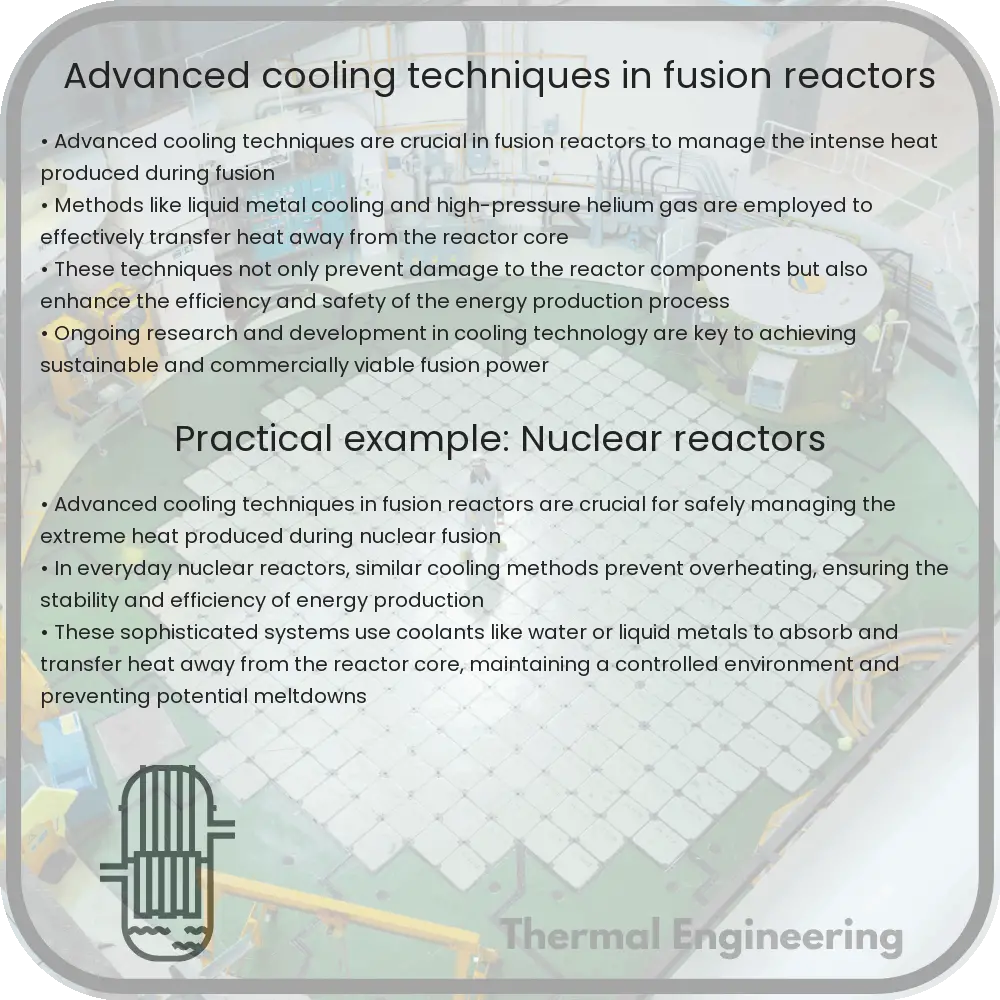Exploring innovative cooling solutions critical for managing extreme temperatures in fusion reactors, ensuring safe and efficient energy production.

Advanced Cooling Techniques in Fusion Reactors
Fusion reactors represent the cutting edge of energy technology—a potential source of nearly limitless, clean energy. As such, mastering the engineering challenges of fusion power is crucial. One critical area is the development of advanced cooling systems to manage the extreme temperatures and energy production. Let’s explore the key cooling techniques currently being developed for fusion reactors.
Understanding Thermal Loads in Fusion Reactors
Fusion reactors, such as those based on the tokamak or stellarator design, operate at temperatures higher than those found in the sun’s core. These extreme temperatures are necessary to achieve plasma conditions where hydrogen isotopes can fuse, releasing enormous amounts of energy. Managing this heat is essential not only for the reactor’s safety but also for its efficiency and longevity.
1. Water Cooling Systems
The most traditional method of removing heat from any high-energy system is water cooling, and fusion reactors are no exception. Water cooling systems circulate water around the reactor core, absorbing heat which is then transferred away from the reactor, often converting it into steam to drive turbines for electricity generation.
- Advantages include technological maturity and high heat capacity.
- Challenges include potential for water to become radioactive and limitations in the maximum achievable heat transfer rates compared to the heat generated.
2. Liquid Metal Cooling
Given the limitations of water cooling, research has turned to liquid metals like lithium or lithium-lead alloys. Liquid metals can handle higher temperatures and offer superior heat transfer capabilities.
- They function both as a coolant and a protective layer for the reactor walls.
- They capture neutrons from the fusion reaction and help breed tritium, one of the fuel sources used in fusion reactors.
3. Divertor Technology
The divertor is a critical component in many fusion reactors, designed to handle the extreme heat flux and manage waste material produced in the fusion process. It acts by diverting and cooling down the unwanted byproducts of fusion away from the core of the plasma.
- Advanced materials like tungsten and carbon composites are often used for their high melting points and thermal conductivity.
- Innovative designs are continually being tested in conditions simulating the internal environment of a fusion reactor.
4. Magnetic Confinement and Cooling
Magnetic confinement plays a dual role in fusion reactors: maintaining the shape and stability of the plasma and aiding in the heat management. By strategically designing the magnetic field, the hottest parts of the plasma can be kept away from reactor walls, thus reducing the thermal stress.
5. Radiative Cooling Techniques
Radiative cooling involves the emission of heat through radiation. In a fusion reactor, certain materials can be introduced to the plasma where they emit radiation, thereby cooling the core. This technique is useful for controlling edge plasma and divertor temperatures.
- Molybdenum and neon are examples of materials used for their radiative properties.
Challenges and Future Directions
While significant advancements have been made in these cooling technologies, many challenges remain. Managing thermal loads while maintaining the efficiency and longevity of the reactor components continues to be a focal point of research. Future breakthroughs in material science and engineering are expected to pave the way for more effective and sustainable cooling solutions in fusion technology.
In summary, advanced cooling techniques in fusion reactors are a vital area of focus in the quest for sustainable energy. By continued innovation and testing, these systems will enable the safe and efficient operation of fusion reactors, heralding a new era of clean energy.